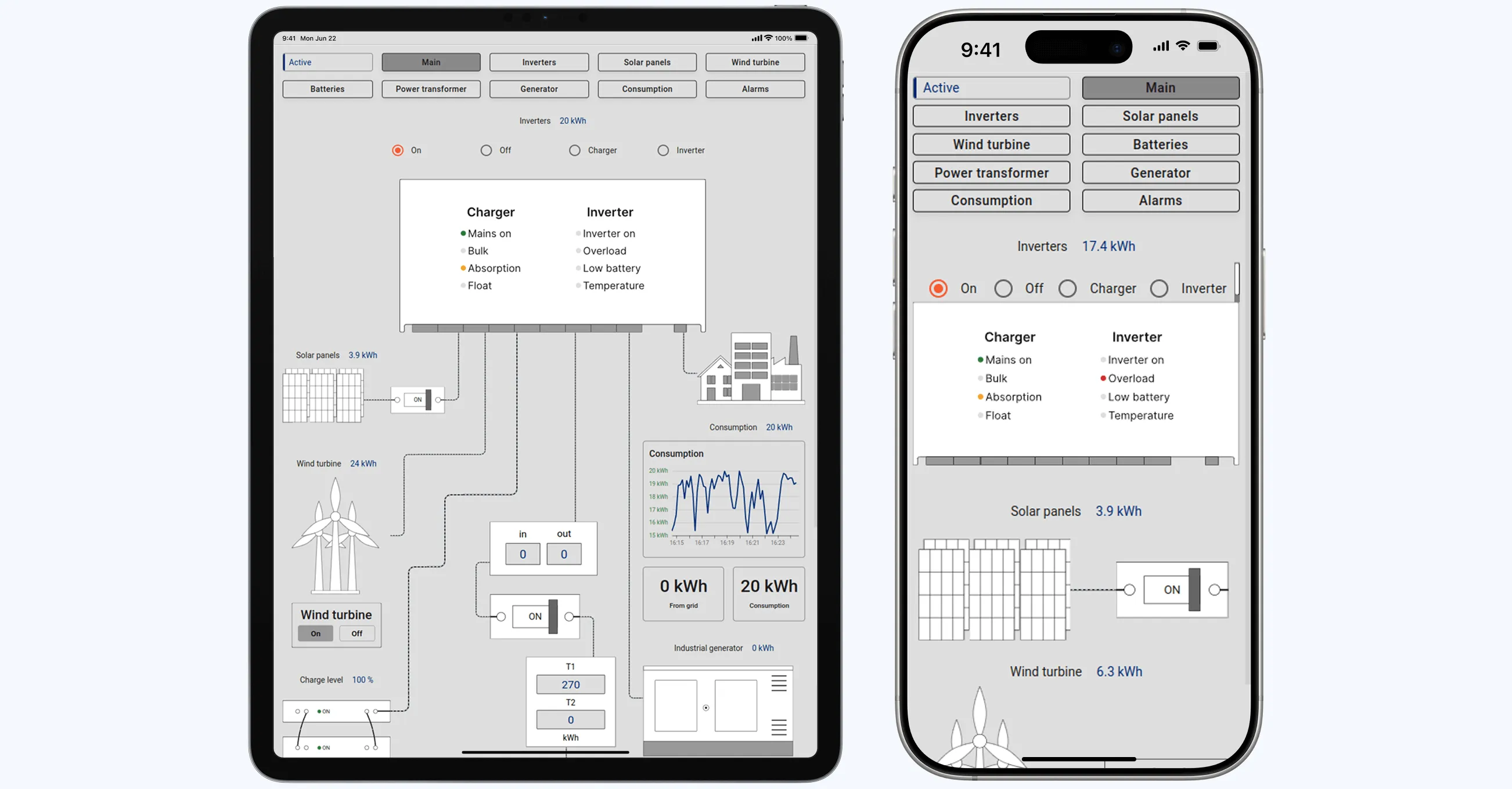SCADA Energy management
SCADA (Supervisory Control and Data Acquisition) systems play a crucial role in energy monitoring and management, providing real-time insights into power generation, distribution, and consumption. With platforms like ThingsBoard, businesses can integrate advanced SCADA solutions to optimize energy efficiency, reduce costs, and enhance system reliability.
The ability to collect, analyze, and visualize data from multiple energy sources helps operators make informed decisions and respond swiftly to changing conditions. ThingsBoard provides comprehensive tools to collect, process, and visualize data from SCADA components, such as PLCs (Programmable Logic Controllers) and RCUs (Remote Control Units), enabling seamless integration with various industrial processes.
With ThingsBoard, you can monitor the performance of all energy sources and consumption points in real time, identify inefficiencies, forecast demand peaks, and respond to anomalies instantly. All of this is showcased in our SCADA Energy solution, demonstrating how easily and effectively energy systems can be managed using ThingsBoard.



Solution structure

PLCs and RTUs
Seamlessly integrate your SCADA system with PLCs and RTUs using ThingsBoard integrations and IoT Gateway. Support for Modbus, OPC-UA, BACnet, and other popular protocols ensures reliable real-time data collection and control.
IoT gateway
ThingsBoard’s IoT Gateway bridges the gap between legacy SCADA devices and modern IoT platforms. It ensures data reliability with built-in local data storage during network outages and supports efficient protocol conversion, secure data transmission, and centralized device management.
Data processing
Unlock actionable insights with ThingsBoard’s robust data processing tools. Perform real-time transformations, apply complex rules, and automate workflows with built-in rule chains and scriptable integrations.
Alarm system
Enhance operational awareness with ThingsBoard’s advanced alarm system. Manage incident workflows with features like alarm acknowledgment, clearing, commenting, and configurable escalation rules.
Notification system
Stay informed with ThingsBoard’s flexible notification system, delivering alerts via email, SMS, Slack, or custom webhooks. Automate critical notifications based on configurable conditions and thresholds.
IoT dashboards
Visualize your SCADA data with ThingsBoard’s real-time IoT dashboards. Design interactive views using SCADA symbols, customizable widgets, and dynamic updates to monitor and control processes seamlessly.
Key functions of SCADA systems
Power generation and renewable energy sources
These symbols represent different energy sources used in SCADA systems for real-time monitoring and control. They include solar panels, wind turbines, and fuel generators, which are essential for tracking energy generation, efficiency, and performance of renewable and backup power sources.

Power distribution and circuit protection
This category includes essential components responsible for managing electrical flow and ensuring system safety. It consists of circuit breakers, voltage relays, and stabilizers that help prevent overloads, regulate voltage supply, and maintain stable power distribution.

Energy measurement
SCADA systems require precise real-time data collection on energy usage to ensure efficient power monitoring and optimization. This group includes various energy meters that provide multi-rate measurement capabilities, helping operators track power consumption accurately and make data-driven decisions for energy efficiency.

Consumption analysis
Understanding how energy is distributed and consumed across different sectors is crucial for effective SCADA operations. This group consists of consumer representation symbols that help categorize and analyze power usage in industrial, residential, and commercial environments, providing insights into consumption patterns.

Power control and transformation
Symbols in this group allow for effective power conversion and distribution within the grid. Transformers, inverters, and transmission infrastructure are included to facilitate efficient power management, ensuring stable energy supply across different voltage levels.

Electrical control and connectivity
SCADA systems require connectivity and user control points for seamless operation. This group includes power sockets, switches, distribution boards, and battery monitoring tools, enabling interactive control and reliable energy storage management.

Environmental monitoring and system indicators
These symbols support real-time environmental tracking and status indications for operational insights. They include temperature monitoring scales and energy system controllers, which enhance automation and provide essential data for system optimization.

System connectivity and network flow
These symbols allow SCADA users to visualize energy flow and system interconnections. Connectors, cross junctions, and elbow connectors are used to represent electrical pathways, helping in grid architecture visualization and network structure planning.

Dashboard structure
Applications of SCADA systems
Industrial facilities
Monitoring and optimizing energy usage in manufacturing plants.
Renewable energy plants
Managing solar and wind energy production.
Utilities and power grids
Supervising grid operations and power distribution.





Smart buildings
Enhancing energy efficiency in commercial and residential structures.
Data centers
Ensuring stable power supply and backup power management.

Industrial facilities
Monitoring and optimizing energy usage in manufacturing plants.
Smart buildings
Enhancing energy efficiency in commercial and residential structures.


Renewable energy plants
Managing solar and wind energy production.
Data centers
Ensuring stable power supply and backup power management.


Utilities and power grids
Supervising grid operations and power distribution.
ThingsBoard advantages
 Security
Security
ThingsBoard protects your data with industry-standard encryption algorithms like RSA and ECDSA. Secure communication is ensured via TLS (TCP) and DTLS (UDP). Role-based access control and audit logs further enhance platform security.
 Data visualization
Data visualization
Visualize data with interactive, multi-state dashboards—no coding needed. Use built-in charts, gauges, maps, tables, and control widgets. Customize every detail via advanced settings or custom widget bundles. Real-time, low-latency updates supported via embedded web-sockets.
 Connectivity
Connectivity
Connect devices directly to the platform via the following built-in protocols: HTTP, CoAP, MQTT, LwM2M, and SNMP. Connect devices in your local network to the cloud using ThingsBoard Gateway via Modbus, BLE, BACnet, OPC-UA, and other protocols.
 Data processing
Data processing
ThingsBoard allows you to define app logic using a drag-and-drop rule chain designer. Its scalable Rule Engine uses message queues like Kafka or AWS SQS for durable, reliable data processing. You can handle data within the engine or forward it to external systems.
 Scalability and high availability
Scalability and high availability
ThingsBoard supports high-availability cloud and on-prem deployments via Kubernetes or bare-metal. Its components scale horizontally and handle 18K+ vehicles and 5K+ devices in prod.
 Multi-tenancy
Multi-tenancy
ThingsBoard provides UI and API to manage tenants, customers, users, devices, and assets. Single tenant may have multiple tenant administrators and millions of devices and customers. It also offers out-of-the-box support of OTA updates for your smart meters.

